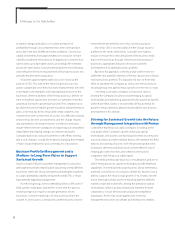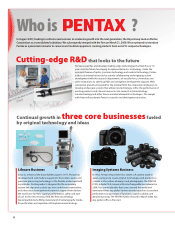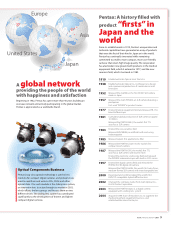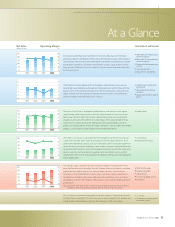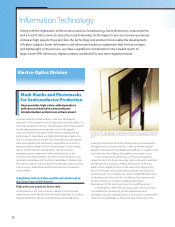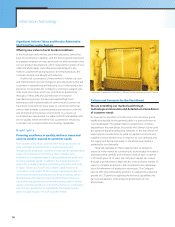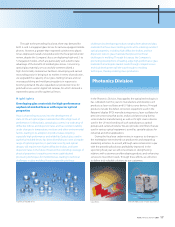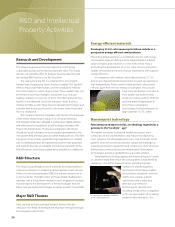Pentax 2008 Annual Report Download - page 18
Download and view the complete annual report
Please find page 18 of the 2008 Pentax annual report below. You can navigate through the pages in the report by either clicking on the pages listed below, or by using the keyword search tool below to find specific information within the annual report.
In an advance response to such demand, Hoya is promoting a
plan to augment manufacturing facilities at its Vietnam
plant—one of its main substrate production centers. We are also
working to reorganize our production system to achieve higher
quality, lower costs and more stable operations, in contrast to past
efforts primarily focused on upping production volume. Our initial
goal is to consolidate marketing, development and production
functions to ensure firm support of customer needs through
speedy development processes that enable swift response to
market changes.
To stay ahead in the fast-moving HDD technology race, the
Company is working to develop state-of-the-art technologies that
look to the next generation and the generation after that. We are
currently focusing R&D resources on discrete track recording
media. By making grooves of non-magnetic material between
recording tracks, this technology reduces the incidence of noise
between neighboring tracks, thereby permitting an increase in data
recording density of 1.5 to 2.0 times compared with conventional
media. With the market anticipating commercialization of the
technology in 2010, advances in media are leading to calls for
technological innovation in substrates. Hoya is committed to
developing and establishing production processes for
next-generation products, utilizing the expertise accumulated
throughout the Group at its R&D Center and other divisions.
Hoya maintains a complete production system capable of
manufacturing everything from optical glass to processed optical
lenses, and develops and manufactures high-precision aspherical
molded lenses and polished lenses used in the photographic
optical units of digital cameras, video cameras, camera-equipped
mobile phones and other devices. In particular, aspherical molded
lenses—Hoya’s forte—have excellent aberration correction
properties, which enable wide-angle settings and require fewer
lenses, thereby contributing handsomely to more compact,
lightweight and functionally sophisticated cameras.
Raising orders of lenses for compact digital cameras by
commercializing technically challenging concave
meniscus aspherical lenses
In the fiscal year under review, demand for digital cameras swelled
in Japan, Europe, North America and other developed countries,
as well as the BRICs markets of Brazil, Russia, India and China. The
market experienced a steady stream of high-performance
compact cameras, especially those having thin, lightweight
designs while sporting high megapixel counts over 10 million and
high-powered built-in zoom functionality. The SLR camera market
is also growing steadily as resolutions improve, the number of
entry-level models increases, operability improves and the units
enjoy greater popularity with female shoppers ranging from pros
to amateurs.
In this environment, demand for Hoya’s aspherical molded
lenses and polished lenses grew in the first half of the fiscal year
under review to significantly exceed that of the previous year. In
contrast, orders for optical lenses fell in the fourth quarter, due to a
downturn in demand for compact cameras that began in the
same quarter and the influence of inventory adjustments by
camera manufacturers. Amid such problematic circumstances,
sales of concave meniscus aspherical lenses grew considerably to
become a core driver of net sales, as customers recognized the
lenses’ superb functionality and quality. Furthermore, production
of SLR cameras has been increasing rapidly in the last several
years, while medium- and large-aperture lenses sustained healthy
sales momentum from the prior year.
Information Technology
Optical Lenses
Advances in superior-performance optical
glass bring more sophisticated optical lenses
Highlights
Capitalizing on synergies with other divisions to
enhance discrete track recording and other
next-generation technologies
Significant Actions Taken and Results Achieved in
the Fiscal Year under Review
Glass memory disks for HDDs: transparent substrates and media
16


